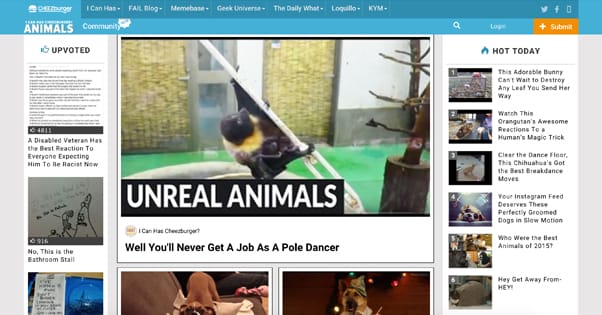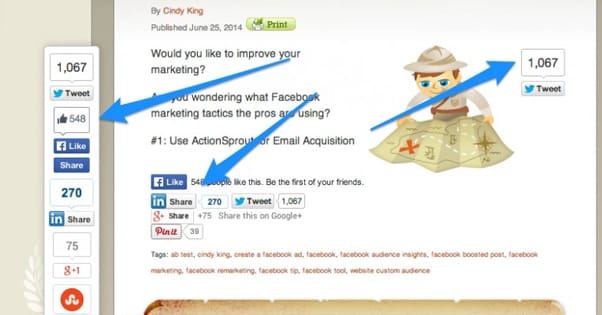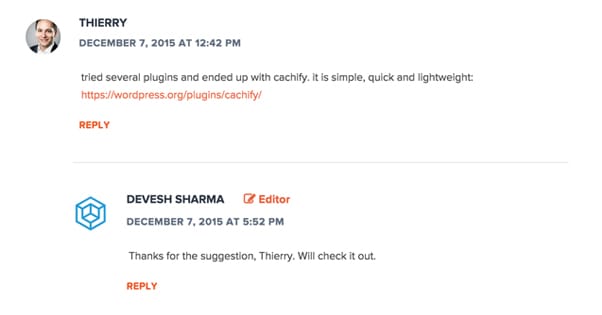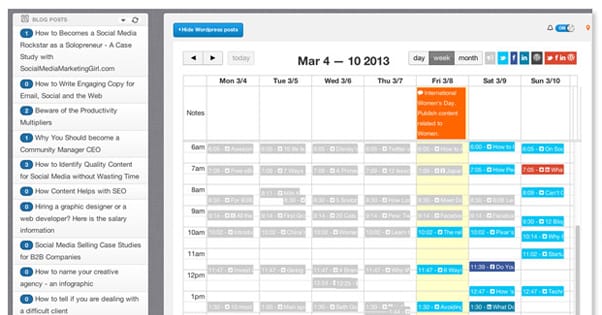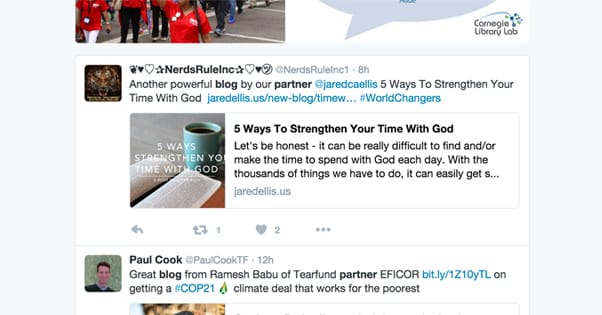What Makes a Blog Suddenly Become Popular?
Published by James Parsons • Content Marketing • Posted December 11, 2015 ContentPowered.com
ContentPowered.com
Some blogs languish for years before getting their big break, bursting onto the scene and becoming the next Upworthy, the next Cheezburger, the next YTMND, the next EbaumsWorld. Some blogs explode onto the web with a crazy launch party and never really fold. Many blogs never see their chance, and hover with a few dozen hits per month for all of time.
What is it that differentiates the popular blogs with the dozen-hitters? What is it that causes a blog to grow? What lightning has to strike, what devil needs a bargain, to reach those heights? Well, let’s take a look at fame and what goes into it.
A Great Blog Has Purpose
If you go into blogging just to write a blog, throw some personal stories out there, and see who comes to watch, well, you’re going to have a bad time. All of the great blogs go into blogging with a purpose. They might be businesses looking to become authorities in their industry. They might be casual blogs looking to advance a social purpose. They might be like the Gawker blogs, covering one particular niche in as great a detail as possible.
Your purpose doesn’t need to be deep or insightful. Your purpose doesn’t need to be unique. You just need to strive to be the best at whatever it is you choose to do. If you’re trying to coast along on personal anecdotes and stories about your children, you’re going to be spending a lot more time writing than people are going to be spending reading. Just go into things with a goal, with a drive, and with a purpose.
A Great Blog is Social
I don’t just mean being a socially affable person, here. What I mean is present on social media. Now, you don’t need to try to be a big business and have an active profile on every single social media network. I recommend picking 2-3 at most and sticking with them. In general, here’s what I recommend:
- Facebook. This is the default. Pretty much every blog should be present on Facebook, unless it’s a rabid anti-Facebook blog, or a “how to hack Facebook” blog, or something similar that will be banned from Facebook.
- Twitter. This is another good default. If you only do two social networks, make it Facebook and Twitter. You’d have to have a very good reason to replace one of them with any other network.
- Google+. This one is pretty great if you’re in a tech niche, and I’ve seen a lot of DIY/Green/Eco niche posts. It’s a lot like a Facebook replacement, but with hints of more Pinterest-like content and audience.
- Pinterest. Ideal if you’re targeting a primarily female audience in the “stay at home” or DIY niches. Less so for tech-focused, gaming, or other primarily male-dominant industries.
- Instagram. A perfect social network if you’re a graphic designer, artist, or photographer. If you’re into visual content, Instagram is the place to show it off.
There are also other networks that are ideal for certain groups of people. MyMFB, for example, is billed as “Facebook for Muslims” and has a sharply growing population. Meanwhile, VK.com is the largest social network in Europe and is ideal for non-American blogs.
A Great Blog Builds Community
This goes hand in hand with having a social presence. You aren’t just putting up content for the unwashed masses to consume; you’re becoming a role model, a thought leader, a public speaker. You’re taking up a very public role, and you need to mingle with your readers to make them feel at home.
Part of this, and possibly one of the most important things you can do as a blogger, is to read, respond, and engage with your audience. You’re not just using software to post your blog posts on social media; you’re monitoring comments and having conversations. You should also keep your blog comments open, though you will have to be on top of anti-spam measures. Too many blogs either ignore their comments entirely or turn them off out of fear of spam, and lose out on a lot of reader engagement that way.
Why do you need engaged readers? Engaged readers feel more invested in your blog. When you respond directly, they feel special, even if logically they aren’t. It’s not as if you’re Elon Musk or Bill Gates responding to some no-name schmuck. Still, engaged readers are good, because they become advocates. They read good information and they’re more likely to share it with people they know who might be interested.
A Great Blog Understands SEO
Yes, like it or not, you’re going to need to know how SEO works if you want to be successful as a blogger. You don’t need to dig in and go full-on marketer mode, but you need to at least understand how keywords work, how links work, and what Google considers spam. This helps you have some idea of what works and what doesn’t, and it helps you avoid all of the scams that show up in inboxes.
If all you want to learn is the very basics of what SEO is and how it works, I recommend this little article. Some of it won’t apply if you’re not a business blogger, but some of it will be very useful to know.
If you want to know more, about how SEO works, how to build value, and how to get into basic internet marketing, you can read the huge Moz guide. Moz is the number one authority on SEO, and they keep that guide up to date at all times. It’s a bit daunting, but you can take it a chapter at a time; most of it won’t come into play right away.
A Great Blog Has Voice
A voice is something you as a writer will develop over the course of blogging, but you need to at least be aware of it and aware of how you come across as a blogger. Blogging is interesting in that it is a cross between formal and informal, and it has a very wide range of acceptable tones. You can be the upper crust corporate blogger writing for an audience of CEOs, or you can be the ultra-casual hippy blogger running a daycare. These are both acceptable options, so long as you’re targeting the right audience. The parents of children aren’t going to want off-putting corporate doublespeak, and the CEOs might be turned off by casual language.
Finding your voice is a topic that many bloggers write about, and there’s a lot of good information out there. A lot of it comes down to just knowing your audience, knowing your topic, and knowing what sort of tone the intersection between them conveys. The rest? Well, that’s just a matter of writing a lot, all the time, and building up practice.
A Great Blog Drives Conversation
Now, what about your content? In most cases, you have a few broad options for content. You can cover a current event or newsworthy issue. You can delve into history or analyze statistics. You can provide a step by step guide for something in your niche. You can dig into opinions and theory in a way that relates to your topic, trying to find a new perspective. You can announce new products and services.
All of these give you methods you can use to include your readers and other bloggers. Looking at statistics? It’s great for being cited in other follow-up posts. Covering news? Everyone likes to chat about the news. Have a guide for something? Ask people if it helped, how you can improve it, and what else you can write a guide for. Always try to find a way you can include the user perspective or ask for feedback. It starts the conversation, which you can continue with engagement.
A Great Blog is Regular
Regularity is important, from bowels to TV schedules to blogging. I’ve made the metaphor before, but imagine if you were watching a TV show and you liked what you saw. You wanted to view episodes each time they air. You tune in the same time next week, and you see a completely different show. You look it up and it aired an hour ago. Now you have to order it from Amazon Video or pirate it. The next week you tune in early to make sure you catch it, and find out it doesn’t air until the next day. What? Unfortunately, you have to work then, so you miss it again.
This is no way to run a TV show. Blogging has a slight benefit in that if a user misses when the post is posted, it doesn’t matter; they can still read the post, it doesn’t go away. Delays are worse, though, because the web has a very, very long history of blogs ceasing to update and never starting up again. Readers fear the worst, and they might decide not to come back for a month and catch up when they return, if there’s anything to read.
Regularity and consistency are incredibly important, so you need to pick a schedule and stick to it. You can always throw in an extra post in important circumstances, but you should avoid committing to blogging more often than you can handle. Start out with two posts per week and go from there, if I’m being honest. That’s enough content to keep activity up, but not so much it’s difficult to handle.
A Great Blog Does Something New
Now, I’m not saying that as a new blog you need to somehow break new ground. It’s difficult to find a niche that hasn’t had anyone running in it for months or years. No matter how minor your hobby or focus, someone has been blogging in it for a while. That doesn’t mean they were good in the niche, though, and that’s your opportunity.
When you pick a niche, make sure it’s something you’re both knowledgeable about and passionate about. Use that passion to create better content than anything the niche has previously seen.
For example, there are a million tech blogs out there. Gizmodo was far from the first, but they’re risen to prominence by producing a ton of content, utilizing a wide range of connections, and getting their hands dirty. They do what other tech blogs do, but they do it better. That’s what you need to do; be the best in the niche.
A Great Blog is Visual
But not too visual. A graphical layout is good; an animated page with content embedded in Flash is not. A logo is good, images in sidebars are good, posting nothing but text-overlaid Facebook memes is not.
Blog posts should be full of images. Try to aim for one picture every 500 or so words, and make that picture related to what was being said in the surrounding paragraphs. It doesn’t need to be deeply illustrative, of course. If you’re writing about writing, pictures of pencils or writing desks or calligraphy all work. Pictures in context are important, but they don’t need to be crucial to understanding the post.
The exception is if you’re creating a how-to with a physical product or process and need to include pictures that show the steps in action. eHow does this a lot with their crazy illustrations, and you can see the same thing in every computer repair guide worth its salt.
Always make sure you’re using images you have the rights to use, of course. If you don’t have the ability to make or take them yourself, get used to using creative commons methods to find them.
A Great Blog is Driven by Hard Work
Make no mistake; you will be working hard to manage your blog. There’s just so much to do! You need to keep up with your hosting and software upgrades, not to mention the bills. You need to make sure your blog design is compatible with various browsers, including mobile devices. You need to make sure your content is high quality, on time, error-free, and promoted as best you can. You need to manage your social media presences. You need to run advertising and make sure it’s not hurting your readers in some way. You need to be developing or looking out for new opportunities to improve, expand, and grow.
Now, there’s a way you can do this and do it easily, but it involves a lot of money. Hire everyone to do everything for you, and all you have to do is be a CEO and administrator. Of course, that takes a lot of cash, and most newbie bloggers are coming into it as a potential income stream, not as an entrepreneurial opportunity.
On top of all of this, you can often labor for years before getting your big break. All of the entries on this list are factors that contribute to success, but a huge part of breaking through is being in the right place at the right time.
A Great Blog Partners Up
There are three types of people who visit your blog.
The first type of people are the people who landed there by accident or were slightly curious. These are the StumbleUpon visitors, the people who click everything they see on Facebook, and the people who just browse from page to page without paying much attention. These people, as readers, are virtually worthless to you.
The second type of people are the engaged readers. These people are participants in your hobby or are interested in your niche, and they like to read what you have to say. They read, they share, they leave comments, and they generally make it all feel worthwhile. However, they also aren’t doing a lot to grow your blog. Their shares may get you a handful of viewers you didn’t have before, but it’s very slow going.
The third type of people are the influencers and thought leaders in your industry. In SEO, for example, these would be the Mozes and the Neil Patels and the Social Media Examiners. These are people with their own established audiences, who aren’t really even competitors; they’re so far above you that your presence can’t hurt them, or they’re in a related but not competing niche.
The third type of people are the people you really want to identify and cater to. They’re the people you want to network with on social media. They’re the people whose blogs you want to be reading, and who you want to strive to out-do.
More importantly, these are the people you want to forge partnerships with. These are the people you want to get to know, and who you want to have on your side. One social share from one of these people can bring thousands or tens of thousands of new readers to your blog. That’s what you really want.
A Great Blog Has a Brand
Moz, Quicksprout, Gizmodo, Upworthy, Buzzfeed, Cracked, PCGamer; all of these sites fit the bill of a blog, and all of them have very strong brands. Name recognition is huge. Having a logo, having a name, having a brand, they’re all amazing tools to helping you grow. It’s a lot easier to grow a brand name like Pepsi than it is to grow a generic name like BestFaucets.
To a certain extent it doesn’t even matter what your brand is, but a lot of thought often goes into it regardless. If nothing else, you need to be aware of trademark law and the effect it can have on your business. Yes, at the end of the day, you’re building a business. Even if that business is just producing content and making money through ads and book sales, it’s still a business.
